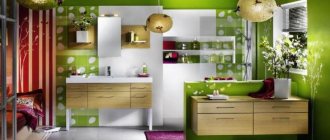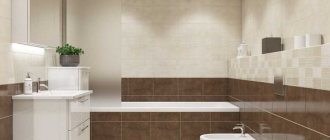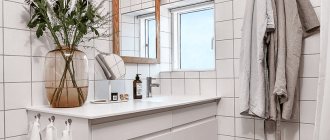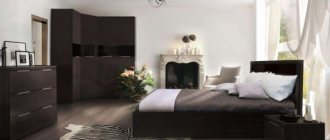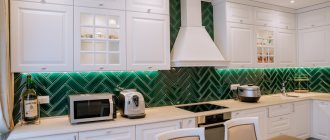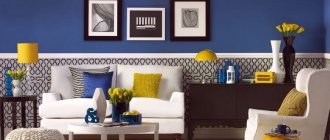What it is
Ceramic tiles have been used for cladding all types of floors for a long time, but the variety of various shapes, as well as patterns, has never been particularly observed.
Such flooring was previously intended solely for the practicality and durability of the floor. Today, it should attract special attention from guests in the home, decorating the design. This is why many buyers previously did not choose floor tiles to decorate their home
Patchwork is a unique technique with unusual patterns combined in one fabric. It originated from sewing patches of various shapes, all kinds of colors and images.
How to combine
Tiles in the kitchen 45 elegant and functional floor finishing options
There will be no major mistakes when matching the pattern, each ceramic tile has a unique pattern. It is not at all necessary to buy ready-made kits in the store. You can easily assemble them yourself, based on your taste. As a result, you will get a unique flooring design.
If you decide to make tiled patchwork yourself, you need to take into account the main aspects in this matter. Tiles should always be used in only one format; calibration is necessary. It must have identical edges, thickness and surface type. This is one of the main rules for a successful purchase and high-quality cladding.
In addition to geometric similarity, the tiles should have one more common feature - the same color. They should echo each other with similar shades. This is how they create all kinds of color combinations that look easy and stylish. It is worth remembering that too much colorfulness quickly tires and irritates over time.
Kinds
The best ideas for rational organization of free space in the kitchen
There are several techniques of this type when decorating rooms. If you decide to use this one of them, then you need to decide on the type.
Patchwork is divided into the following categories:
- Chic is a professional finish that resembles the texture of natural wood.
- Colea is a technique used for the bathroom.
- Vives is a technique that looks better in a standard kitchen interior and can be used in any room in your home.
- Vodevil is a technique that is famous for its complex patterns.
This is only a subjective division into categories, because there are many more patchwork techniques; there are no restrictions in this technology. This technique is also used for paving slabs. Today, such tiles are used in many areas of construction.
If you have previously covered a floor with multi-colored floor tiles of the same size, laying out different compositions from colorful tile fragments, then you are already familiar with the patchwork technique. This is a kind of mosaic of identical tiles, through which a certain ornament is laid out.
Kitchen design tips
Living room in Provence style
Decorating a kitchen in a “patchwork style” is a new, fashionable trend. It allows you to use original, non-standard solutions in its design. But here, as in everything, it is necessary to observe moderation. Here are some tips to help you correctly use patchwork tiles to create your kitchen interior:
When decorating a kitchen interior, patchwork tiles with bright floral patterns or geometric patterns against a background of plain coffee or beige tiles are best suited. The furniture in the kitchen should be made in a laconic and simple style. The colors of the tiles should be combined with the shades of furniture and kitchen accessories, which, in turn, should not be full of bright colors. A black and white stylization of the room with individual color accents of “patchwork” tiles looks ideal. They enliven the interior and give the room a special play of color. The kitchen interior should not be “overloaded” with decor. If the kitchen is large and spacious, then it is better to use patchwork in soft colors for the floor. Floor tiles in pastel colors are an ideal interior option, provided that furniture in warm, autumn colors is used. In a small kitchen it is better to use bright and small elements. Don’t cover the entire floor in a small kitchen with patchwork porcelain tiles - make a small “mat” of tiles in the right place - it will fit perfectly into the interior of the room. To create a harmonious atmosphere, it is advisable to arrange a kitchen apron from patterned tiles. It will decorate the room, make it elegant and festive. When using it, you can stylize the kitchen in the spirit of minimalism - abandon various decorations, facades with large handles, and bright interior elements.
When decorating a kitchen apron, the main part of the design should be placed in the center, at eye level, and small details should be placed at the edges. When alternating patchwork tiles, it is recommended to use products from the same manufacturer
If you need to create a composition from tiles of different brands, then you should pay attention to the color and texture of the material. When laying tiles on walls and floors, you must use the same pattern on their surfaces. A truly win-win option for kitchen design is the selection of tiles that imitate natural materials. It looks noble and does not “muffle” the beauty of the furniture.
The use of decorative tiles and porcelain tiles in a patchwork style can significantly embellish the interior of a room. Make it bright, unforgettable and original. A large selection of colors and patterns will allow you to independently or with the help of a designer assemble a whole composition from individual “shreds”, bring any design fantasy to life, and stylize the room in the right way
The only thing to remember is that patchwork tiles should not attract attention, but only complement the interior
Beautiful ideas for different rooms
Patchwork tiles can adequately decorate any interior of a living space. Most often, it serves as an accent element of the interior: it is used to decorate decorative inserts, highlight the necessary areas, lay out excellent panels, separate walls or the floor surface. It should be borne in mind that oversaturation with patterns can create an irritating impression, especially in small rooms.
Patchwork tiles in the living room interior
Special attention is paid to the interior design of the hall - here it is necessary to create the most comfortable and, at the same time, beautiful environment not only for household members, but also for family guests. Patchwork tiles, combined from different patterns, can turn into a charming wall panel that resembles a kaleidoscope. A patterned floor that will replace a colorful carpet in the living room will look great. Using tiles, you can successfully zone the kitchen-living room space, designating, for example, a recreation area.
Patchwork tiles in the kitchen interior
In the kitchen, patchwork tiles will be an excellent assistant in creating decorations - after all, this room is often deprived of a large area, which does not allow placing more global interior decorations. A patchwork rug can be used to define a dining area or backsplash. In this case, it is necessary to choose a monolithic set without any prints, colorful inserts or other decorations that will distract attention from the main decor. A monochromatic surface covering in combination with tile patterns will look best.
Textiles made in patchwork motifs will complement the setting well. For this room, you can choose tiles with a smooth surface rather than a textured one, which will greatly simplify cleaning.
Patchwork tiles in the bathroom interior
If you are not the happy owner of a large apartment or private house, then you will definitely face the problem of finishing a tiny bathroom. Often the choice falls on a design with wall decoration in light colors, which is completely justified, because such a palette makes the space more spacious and airy. The use of patchwork tiles will help turn even the smallest room into a real masterpiece.
It is better to opt for small tile sizes, not exceeding 20x20 cm, then the decor will not oversaturate the room, and large patterns should be left for spacious bathrooms. To decorate the floor surface with a patterned rug, experts advise choosing matte tiles whose surface does not cause strong slipping.
You can create interesting accents by using tiles sporadically to highlight a particular area. This type of finish would look great on one of the walls of the shower room, as a lining for a bathtub or sink. To visually enlarge the space, you can lay out tiles in the form of horizontal and vertical lines.
How to choose a color scheme for the kitchen
Patchwork can also be islands like this.
For patchwork, the choice of color is important. Initially, it seems as if the purpose of creating a certain stylish element was to pile up bright colors in the room. If in the patchwork style bright colors are correctly combined with plain colors, for example white, then even skeptics will notice the attractiveness and irresistible, fabulous ornament that imparts beauty and comfort to the interior.
The most unexpected options can be combined
Typically, patchwork to decorate the style of the kitchen is used in calm white, warm autumn shades. To create a seasoned interior, you should add to it a kitchen set with scuffs in an antique style. To create an idea for a stylish solution, you can use one of the noblest and most commonly used colors in patchwork - reddish brown. Its shades can also be used in surrounding furniture, but the kitchen apron will look most presentable in this solution.
Patchwork in one color scheme is very common
You can make an apron in a patchwork style in a contrasting version. The color scheme of the walls in the apron area can be done not only in bright shades, but also in the color of natural linen, burlap, and unbleached wool. Such an apron will look great if you make the rest of the space close to the shade of milk; you can complement the interior with the same handmade chair covers with your own hands.
Or it can be so, the main thing is that bright notes do not dominate
Patchwork, made in the postmodern style, is the newest and most unusual option, which is created by an amateur. If the owners of the room decide to make an apron in this direction, then the type of cladding, in addition to patchwork, should combine classic modern and pastoral styles. Daguerreotypes would be an excellent addition. This cocktail reflects the fashion trends of the 19th and 20th centuries, but at that time such a mixture was impossible.
Here's a patchwork in a modern kitchen
But this is a beautiful, seemingly handmade patchwork
An apron with patchwork elements will fit into any interior
Browse the patchwork style collections from ceramic tile manufacturers Kerama Marazzi:
Patchwork style bathroom with dynamic colors
Boho, pop art and kitsch gravitate toward an abundance of multi-faceted furnishing details with colorful colors. Imitating covering a floor or wall with a ceramic carpet, as if woven from multi-colored threads, will best reflect the ambiguous decor of these design styles, which promote the elegance and catchiness of every detail.
The prism of colors used when decorating a bathroom in the patchwork genre has no tonal restrictions:
- all kinds of bold color accents are welcomed, expressed in a contrasting combination of catchy tones - purple and light green, ultramarine and ruby, red and blazing red with scorching energy;
- the use of unexpected tones for the bathroom is encouraged - burgundy, khaki, gold, silver, purple, berry;
- The use of ornaments with complex outlines, painted with neon colors, is approved.
Contrasting combination of bright colors
To create an imitation of a man-made product in a patchwork style, bathroom tiles are decorated with integral elements of sewing and knitted products:
- the edges are decorated with imitation of various stitches, overcast seams;
- the decor reflects the finishing with multi-color buttons, appliqués, embroidery and jacquard patterns;
- The design perfectly accurately copies the loop-like texture of woven fabric, made using different knitting techniques.
Bright accent wall in the bathroom interior
No other design style allows for such imaginative bathroom decoration. In addition to incompatible colors, one composition can easily coexist with openwork patterns with strict geometry, imitation of natural material coatings and swastika images with sacred meaning.
The peculiarity of the patchwork technique is the use of colorful decorative elements in the form of patches without any schematic layout rules. Thanks to this, each composition turns out to be completely different in a single copy with a unique design.
Patchwork tiles for the kitchen room
The patchwork technique combines colors and textures and was first known as a textile technique. But still, this elegant, skillful form is becoming popular in other areas.
Patchwork tiles take on this colored pattern. This approach has almost no thematic boundaries - since this style is suitable for both ultra-modern design and strict classics. Likewise, such an element connects different purposes, thanks to which it contains the specifics of an eclectic style.
Patchwork tiles in the interior - photo examples of kitchen arrangement
Patchwork panels can be used to decorate kitchen walls to replace paintings, paintings and aesthetics. A colorful “mix” of patchwork styles and patterns can be placed just on part of the wall or cover it entirely. Patterned patchwork tiles are considered an interesting alternative, which is better suited as a contrast with simple furniture and smooth facades of kitchen furniture.
For finishing work, we can use ready-made collections or try to create our own compositions by selecting tiles of the same format and laying them in random order. Likewise, laying tiles in a patchwork style becomes a natural art that you can perform personally, implementing your own creative concepts. In this case, you should coordinate the pattern with the interior style and key colors that dominate the room.
A background made of patchwork tiles will aesthetically highlight the structure of wooden facades.
By choosing this tile option, you can rely on minimalism in your kitchen design. In the same way, we will achieve a subtle effect without a feeling of satiety. You can refuse other decorations, for example, facades with large handles or an abundance of other patterned or light-colored components.
Patchwork tiles for kitchen backsplash
The apron above the kitchen countertop is a fairly representative free space. More and more attention is being paid to its cladding. Not only for practical reasons, but also because of aesthetic value, materials are selected for it in today's kitchens. Patchwork tiles are considered an exemplary motif to balance these two aspects. This is a conservative method to present the avant-garde in the interior. Despite the fact that this area is small, it is located in an open, clearly visible place - this is an excellent solution.
The ambience of the kitchen with geometric and floral motifs in bright colors can be applied with all other tiles. Such a combination of patterned and monochrome tiles will create an attractive effect that will become inimitable.
Patchwork floor tiles on the kitchen floor
Ceramic flooring is considered a traditional material, which is characterized by unsurpassed comfort. But still, this practical floor decoration does not have to be uninteresting.
Nowadays there are many attractive flooring options, such as wood-look tiles for the kitchen or honeycomb tiles, but patchwork is an equally good option. This can be patchwork tiles in pleasant colors or bold light colors.
Photo. Honeycomb floor tiles in patchwork style for kitchen floor
For adventurous interiors, you can try to create a real riot of colors on the floor. Moreover, such a strong accent can be used in a minimalist interior.
Patchwork tiles for walls and floors
Variations of this style show that even patchwork tiles don't always have to be associated with glamour. You just have to follow a few rules, and complex arrangements will have their own charm. When laying this tile on the walls and on the floor or on the apron and walls, you need to use the same pattern on two surfaces.
The key theme on various surfaces should be harmony. The color of other elements in your room should be repeated in the cladding using tiles, then the harmony will be very complete. “Patchwork” tiles look very nice in a black and white room interior in combination with other cladding elements in white and black. Some colorful accents will give the room a play of color and enliven the interior.
A well-thought-out interior design must be perfectly coordinated with all components and the dimensions of the room. With patterned tiles you can easily “achieve” a negative effect that will dazzle your eyes, so if you have a small room, it is better to make clear and small accents.
Features of the scope of application
Where can you use unusually painted tiles? In the same place as traditional tiles. These are bathrooms, toilets, kitchens, balconies, entrance areas of hallways. Tiles can decorate walls and floors.
- For example, rugs on the floor, folded using the described material, look beautiful. They help to designate functional areas and set the dynamics of the entire design.
- Using patchwork tiles, designers love to create accent wall panels. They become an interesting decorative decoration for any room; most often the panel is assembled above the dining table. It looks quite natural in this area of the room.
- There are ready-made solutions that demonstrate how well you can use patchwork tiles to highlight a sofa or TV area in the living room. To avoid excessive variegation, it is necessary to combine bright accents with a light monochrome background. In this case, the interiors turn out to be light and interesting.
- Examples of unusual uses for patchwork tiles include lining the steps of the stairs leading to the second floor of your own home, or lining the fireplace in the living room.
- The most traditional option for using the material described is creating a kitchen apron.
Note! Any tile made using the patchwork technique has active patterns. If there are a lot of tiles in the decoration, it will definitely attract attention. Poor placement of a huge patchwork quilt will break the geometry of the space. This will make the room uncomfortable. A large amount of ornamentation quickly tires the eyes, so it is necessary to use patchwork tiles in the decoration of living rooms in extremely measured doses.
Beautiful options
Finishing the floor with this technique is a common option for using tiles. The material may differ in size and surface texture. More often it is glossy, although recently a matte variety has appeared on store shelves.
If we consider in detail the variations in the decor of floor tiles, we can distinguish the following types of ceramic products:
- imitation of other materials (for example, wood or stone);
- abstract patterns on tiles;
- monolithic tiles with a special texture.
- bright rich colors.
Today the trend is tiles with all kinds of patterns. It can be purchased from Russian manufacturers or foreign brands.
For example, we can highlight the company Cicogres (Spain), whose products are quite popular. The Spanish manufacturer has been maintaining the brand for several years and takes pride of place in the construction floor ceramics market. The manufacturer produces various designer products that combine bright colors and unique stylish patterns. With all this, the tones remain quite simple and are emphasized by contrast.
Shades can be selected according to the interior of the room. If you choose yellow floor tiles, you can experiment and buy green wallpaper. It will be unusual, but quite stylish and fresh. Maximize your design skills and creativity. If you need to support the color scheme of the interior, you should choose the material in such a way that one or two shades match.
Principles of patchwork technique
Since patchwork has spread to the masses by leaps and bounds, it would not be amiss to mention the main nuances of the work.
- To make the artistic space of the room seem unified, you need to skillfully combine drawings. It is worth remembering that the tiles must match in color, be of a single format, and their patterns and designs must resonate with the overall design of the room;
- It is customary to place the largest drawings and panels in the center of the composition, at eye level, and small ones - at the edges;
- If you finish only with patterned tiles, they will be annoying, so you need to combine them with plain ones: the approximate ratio is 30% textured, 70% smooth;
- Patchwork can be monochrome, multi-colored and even 3D. The surface of ceramics can be smooth and textured, matte and glazed - all these factors must be taken into account when combining;
- It is best to buy tiles from the same manufacturer: the material should be the same not only in width and length, but also in thickness, type of edge and method of surface treatment;
- Floral patterns are most common, geometric shapes and abstractions are less common. Depending on the purpose of the room and the style of the interior, the pattern is selected.
Features of application
Considering the variety offered, it is difficult to independently choose a successful combination and apply it in the design of a particular room. Some tips from experienced designers will help make the task easier. Let's indicate the main ones.
Note! In the absence of a certain artistic taste, ready-made kits compiled by designers working at manufacturing plants help to simplify the solution to the identified problem.
You can choose a patchwork yourself, taking into account the following subtleties:
- It is important to purchase tiles of the same size, equal thickness, and having the same edge.
- Patchwork style cladding looks harmonious if the tile surface is treated in the same way.
- Patchwork is a combination of different patterns; in order for them to come together into one overall picture, it is necessary to ensure that at least one correspondence occurs between the individual tiles (either in color, or in style, or in the manner of execution).
- The easiest way is to combine monochrome tiles, as well as tiles whose design contains no more than three colors.
Note! If you put together a picture of patchwork of different colors, different styles and different patterns, it will irritate the eye, excite the nervous system, which will negatively affect the overall perception of the decoration of the room. A similar technique can be used, but in a strictly dosed manner, to highlight special design accents.
Interesting solutions in the interior
The most popular choice is a two or three color mix; a multi-color “bedspread” is not suitable for every room. Blue-white, black-and-white and chocolate-beige variations are popular. However, bright canvases also look very interesting.
A contrasting combination is patchwork-style tiles with imitations of natural materials. Tiles that imitate a wooden, concrete or stone surface will highlight the excessive diversity and look very noble. It is a kind of background, the main thing is to choose the appropriate shade: cream, steel-gray, white, and coffee colors are popular.
The patchwork itself is quite self-sufficient, but be prepared for the fact that such a mosaic floor will outshine all other objects in the room and will invariably attract attention only to its own person. For such a room, you should choose monochromatic furniture, but prints on curtains or pillows are quite appropriate - they should echo the patterns on the floor or walls
If you choose patchwork tiles to decorate an accent wall, you can afford to experiment boldly not only with colors, but also with sizes. In the collections you can find not only square or rectangular tiles, but also hexagonal or oval ones - it’s time to get creative!
There should be only one accent wall in the room, otherwise the room will be overloaded with textures and patterns and it will simply be uncomfortable to be in it.
Fragmentary decoration also looks good: individual elements such as niches, steps, columns, surfaces above the fireplace enliven the room and give it a special coziness.
In small rooms, small motley tiles will be appropriate; a large panel will visually make the wall smaller. Other finishing elements should be painted in calm shades. For large rooms, it is quite possible to choose catchy textures and massive patterns; with the help of “patchwork” tiles, you can place accents and zone the room. If there are not many patterned tiles, choose contrasting colors - pastel and bright.
For the kitchen, floral or geometric patterns are often chosen and combined with plain tiles. The so-called “Gzhel” (white and blue tiles with painting) looks good. By the way, you can decorate not only a kitchen apron in a patchwork style, but also shelves, niches, a bar counter, and an accent wall above the table.
In the living room and dining room, the floor is often decorated using patchwork techniques. You can place a large panel in the center of the room - instead of a classic carpet, you can make small inserts, and if desired, make the entire surface colorful and catchy.
Such tiles are also appropriate in the bathroom, hallway, and loggia. It must be selected taking into account the overall style of the room. For example, for a vintage style, delicate, seemingly faded designs are appropriate. Provence also requires calm pastel colors, but bright mixes will also look organic in country style. Monochrome combinations of Dutch ceramics and Gzhel will suit the Mediterranean and classical styles; Moroccan and Oriental styles are characterized by rich shades and a large number of patterns. For a modern room, it is better to choose monochrome compositions.
Collections of tiles in the patchwork style are represented by many manufacturers: Chik from Cicorges, Patchwork from Almera Ceramica, Roivoli, Aranjuez and Vodevil from Vives, Patchwork from Realonda, Mainzu from Rialto, Country&Masia from Equipe, Saint Tropez from APE and others.
Patchwork style tiles are a bold, but certainly successful solution that can transform even the most boring and dull interior!
- Carpet tiles.
- Ceramic tiles in oriental style.
Style and color
Patchwork style tiles can be used in almost any interior if you choose the right pattern and color.
Minimalism
Here you can use patchwork tiles in both neutral tones - gray-white, gray-black, and colored ones - in beige and blue tones. Bright patterns like this will add brightness and homeliness to strict minimalism.
If the entire room is made in monochrome, you can decorate it not only with bright colors, but also with one-color or two-color tiles with imitation patchwork - the main thing is that these colors coincide with the main colors of the rest of the decoration. In this case, patterns become the main decoration. They can be laid out in such a way as to make up some kind of pattern, or, on the contrary, “broken down” - this will create an additional decorative effect.
The photo shows an example of a monochromatic apron in the kitchen.
Country
In this style, the use of patchwork technique looks most natural. It is acceptable to use monochrome ornaments, as well as multi-colored patchwork tiles, however, for the kitchen, multi-colored ones are often used to complement the artistic image.
Retro
The patchwork technique is a historical tradition, so patchwork is great for decorating retro-style interiors. As a rule, select patchwork tiles with a pattern that gives the impression of being half-erased or slightly faded.
Other styles
The Dutch tradition of ceramics in white and blue colors, which came to Russia and was developed in Gzhel, is perfect for both country and Scandinavian styles. The white and blue color scheme gives the cladding lightness and airiness, so it can also be used in Mediterranean, Provencal and classical styles.
How to decorate the interior
This technique is used by many designers for modern and ethnic design trends. Mostly it is Provence, country and similar styles. For her, the main colors are white or gray tones.
In the interior of any room in the house, patchwork ceramics will be the main source of expressiveness and mood. This way you can refresh your interior and add brightness to it. Your room will become special and unique.
If the home is made in monochrome colors, you can use tiles that have two colors. Also, quite often, designers use the technique of difference, when the tiles differ in ornamentation, and not just color. Country music is closer to this theme than other genres. It also has many patchwork patterns in the interior elements.
Patchwork in blue and white tones looks quite gentle and relaxed. The airy structure of floor tiles gives your interior a special elegance. Cladding in this style will look advantageous in classic interiors. Please keep this in mind when purchasing. The use of a tiled combination of patterns will look beneficial in vintage interiors.
Many people may think that this technique can be used in any style, but some basic principles must be observed.
For small rooms, you must follow the basic rules:
- the interior should have a minimum of decor;
- the furniture in the room should not be too bright, the upholstery print is undesirable;
- The size of the drawing must be selected taking into account the available area.
For a small room, it is harmonious to use a patchwork-style flooring. Today it is quite popular. For the overall composition, you can use bright colors in small quantities, even if this is not typical for you. This will help add a bright accent to a boring interior.
Pay attention to the style: such tiles are not appropriate in every direction. If the area of the room is small, you can beat the lack of space using zoning techniques
Such tiles can be combined with a plain one, or you can lay out a small canvas from colorful fragments, framing its edges with an original border.
Do not overdo it with dark and cold tones when choosing multi-colored material. This way you can visually hide the degree of lighting in the room. Do not use a huge number of shades in the decoration: they will look more harmonious if there are no more than 4 - 5. It is advisable that the design have monochromatic inserts: this way it will look more interesting.
To learn how to choose a tile, watch the following video.
Using patchwork technique in the interior
The “ancestor” of patchwork is the country style, in which patchwork mosaic will look as organic as possible. The theme will also include a spectacular white and blue combination (like Russian Gzhel or Dutch ceramics). This wall cladding looks airy and will undoubtedly decorate the room, adding light and space. Also, a similar design is appropriate in the Mediterranean, classic style and Provence interior.
“Patchwork quilts” on the walls will enliven the room, adding brightness and mood to it. Calm two-color tiles, repeating the main palette of shades used in the room, are also suitable. To highlight the retro interior, you should choose monochrome patchwork ceramics with the effect of a faded ornament. Interestingly, there are also patchwork options made of smalt (colored glass) that have a 3D effect.
Kitchen interior in patchwork style
If you want to “lift the mood” in your kitchen and surprise guests with an unusual interior “not like everyone else’s”, feel free to decide to decorate the walls or floor of the kitchen in a patchwork style. A panel of multi-colored tiles will fit perfectly into a “wooden” kitchen, adding coziness to the interior. At the same time, patchwork is an attribute not only of “rustic” styles, but can also decorate even a modern high-tech kitchen or loft interior.
Patchwork in monochrome shades will take its rightful place in a minimalist style, soften its severity and add coziness to the room.
For kitchens in white, the decorative technique of patchwork is simply a real find. The Scandinavian style in the interior can be complemented with decorative tiles in white and blue tones. Bright masonry can serve as a kitchen apron, and if you want to add a “zest” to the room, use voluminous tiles that have a textured feel. You can also decorate a bar counter or another partition zoning the kitchen with patchwork tiles.
An interesting technique is to create an accent on one of the walls, the main thing is that the remaining elements are of a restrained design.
Patchwork looks unusual but advantageous in combination with other natural finishing materials, such as parquet.
Options for decorating a bathroom using patchwork tiles
Decorative patchwork coverings are always very elegant, so a bathroom and toilet decorated with such tiles will turn out to be very unusual. There are several tips on how to fit patchwork into the interior of a bathroom:
- Use inserts in the form of randomly located elements of patchwork ceramics on the wall, while the ornament and color may vary, the main thing is to maintain the overall style of the room.
- You can focus on a specific object, such as a sink. In this case, the furniture should be neutral in color: white, beige, light blue or gray.
- A pattern in the form of a narrow stripe on the wall will visually increase the area of the bathroom. Also an effective design technique would be to lay a patchwork pattern on the floor with an imitation of a rug.
Types of patchwork tiles
Modern manufacturers of ceramic tiles offer ready-made collections of various patterns, in various colors, which can be freely combined when decorating the interior. The variety of designs and their colors is amazing. These can be geometric patterns or floral prints, or a combination of both. The most popular types of patchwork tiles:
- neutral black and white or blue and white and their shades;
- multi-colored patchworks;
- modern three-dimensional 3D patchworks.
Laconic patchwork in black and white.
All types of patchworks come with a plain background tile.
The sizes of tiles can be very different - from small square to large rectangular. The tile can also be hexagonal. Multi-colored patchworks can be bright or matte. The design is not necessarily geometric or floral. It can be an imitation of natural wood or stone. The uniqueness of the kitchen interior can be created with the help of individual designer painting of tiles with special paint for porcelain. White clay tiles produce the effect of a mirror surface, which looks great next to tiles that imitate a concrete or stone surface. Blue and white tiles reminiscent of the famous Gzhel will add special elegance and sophistication to the kitchen.
With the help of patchwork, you can create a real artistic panel, boldly combining colors and patterns. This process is complex and painstaking, requiring impeccable artistic taste. Therefore, we advise you to first consult with a professional designer or familiarize yourself with examples of patchwork tile design presented on the Internet and in specialized literature. And as a result, your efforts will be rewarded with a unique interior that will please the eye.
Stylish kitchen decoration.
The beauty of patchwork is the absence of strict rules, which allows you to realize any aesthetic fantasy. Modern patchworks are a real find for designers, as they can decorate and elevate any modern interior.
Patchwork ceramics for the kitchen
This material is an integral part of the kitchen and can become a key part of its design. Patchwork offers something completely different than any other style of pottery. Creative shapes, sophisticated designs attract attention and instantly make a feature wherever they are used. It works equally well in a modern or traditional setting.
Whether the purpose is to add color, texture or simply to make a room water-resistant, patchwork is used to add a unique touch to any scheme, as it often contains ethnic or retro combinations. They perfectly set the tone and dynamics of a kitchen scheme.
Stylish kitchen in dark colors
Patchwork is versatile enough to be used on floors or walls. Another reason why this style has become so popular is that it adds a designer look that looks more expensive, but at the same time, patchwork can be just as cost-effective as other tiles.
Origin story
Its rich history also contributes to its charm and mystery. The image of patterned tiles originated in the Mediterranean countries - Spain, Portugal, Morocco, Italy, Greece. This cultural background has led to this design being also known as Spanish tile, Moroccan tile, wicker tile, bohemian tile (boho tile), or even DIY.
The modern version of the tiles on the market are inspired from around the Mediterranean. Thanks to the combination of decorative patterns, geometric patterns, faded motifs, it is suitable for giving life to walls or floors.
Black and white colors for the room
Patchwork style
A ceramic backsplash in patchwork style attracts attention at first sight
Patchwork in the interior is formed according to the mosaic principle. Multi-colored modules are laid out in a certain order. A patchwork picture is being assembled. This technique does not provide for a single application, but the creation of at least several bright areas in one room. The exception is small areas where the style is used, in particular, the creation of a kitchen apron. This kitchen will perfectly diversify a monochromatic interior. Read about Scandinavian-style kitchen design at this link.
And this is what the patchwork on the floor will look like
In some cases, owners decide to use the patchwork technique when they have several types of tile modules of the same size left. This design direction allows you to combine elements in different color schemes, sometimes with different shade intensities, since the whole picture is assessed “by eye”.
Advantages and disadvantages
Advantages:
- the possibility of independently assembling a design composition;
- tiles can be composed of colored modules, different collections that differ in style;
- freedom in choice and combination of colors is provided. There are no restrictions in patchwork style;
- there are many manufacturers selling special tile or mosaic sets designed in patchwork style;
- an original solution is created that will fit perfectly into both the interior of traditional English and marine design.
Flaws:
- it is difficult to choose the appropriate combination of tiles, especially if the surrounding background is not uniform;
- difficulties in combining patchwork with other bright and original styles;
- a bright background is created, it is almost impossible to overshadow it with any accessories. The only exceptions are patterns in pastel shades;
Ceramic tiles in patchwork style - art in the interior
The unique technology for creating exclusive clothing and household items has been continued by tile manufacturers. Suppliers delight customers with a variety of collections with fancy patterns. The use of mosaics allows you to create unusual interiors with beautiful patterns. The tiles look great in rooms decorated in classic and ultra-modern styles and are suitable for creating interiors with eclectic elements.
Patchwork tiles in Gaudi style
Patchwork tiles with geometric pattern
Blue patchwork tile
Fancy tiles harmonize especially well with minimalist furnishings.
Experts recommend that when choosing a room design for decorating with patterned ornaments, give preference to quiet furniture, facades of sets with strict handles, so as not to overload the interior with bright details.
Patchwork tiles in the living room interior
Gray patchwork tiles in living room decor
Graffiti patchwork tiles
Popular Applications
Patchwork ceramic tiles are successfully used in many modern interiors. If the color of the other elements used in the interior of the room is combined with the tiled finish, then the patterned tiles will harmoniously fit into the design. But most often, “patchwork” technology is used for the following purposes:
- Kitchen and bathroom wall cladding;
- Design of columns, individual interior elements;
- Kitchen and bathroom flooring;
- Decorative covering for loggia, balcony, veranda, dining room;
- Apron installations for the kitchen.
The use of the “patchwork style” in these rooms is carried out both by completely covering the walls or floor with patchwork tiles, and by including it in certain areas - to decorate or highlight the object. After all, the edges of the numerous patterns of this tile are drawn in such a way that it can be used with all decorative elements.
The design of functional areas of the bathroom with patchwork tiles looks very original. In this case, the tile forms a separate element of the interior and emphasizes the space of the shower corner or wash area.
The ability of ceramic “shreds” to make a space brighter and to highlight it correctly determines the widespread use of patchwork tiles when styling small spaces: balconies, verandas, loggias. This also explains the frequent use of this decorative covering on staircase steps, when highlighting individual interior items and columns.
But let’s look at decorating a kitchen in a “patchwork” style in more detail. Let's give some practical tips on how to properly “patchwork” your kitchen space.
Bathroom in patchwork style with an emphasis on ethnic motifs
The colorful decoration of a bathroom in a patchwork style can convey the flavor and ethnicity of any nation in the world:
- Eastern design trends with eye-catching variegated colors - orange and sand to match the desert landscape, bright yellow and crimson, imitating sunrise and sunset in the land of the rising sun. In order to expressively indicate the dominance of oriental motifs on the bathroom cladding, the decor must include ethnic ornaments: arabesque, buta, moreska, paisley and many others.
Oriental notes for a patchwork style bathroom
- Rusticism with a restrained color palette and ancient Russian teratological ornaments, dominated by images of animals and birds with archaic images.
- Italian style with grotesque and zoomorphic ornaments illustrating various representatives of flora and fauna, fantasy creatures, theatrical masks.
- French style with a trellis lattice pattern made up of diamond-shaped elements with small, molded rosettes.
- Floral and floral motifs embodying the natural landscapes of Provence.
Tiles with floral patterns for a bathroom in Provence style
- Antique Gothic with zigzag chevrons, scaly and arrow-shaped patterns.
- Modern modernism is manifested in geometric patterns with expressive broken lines, multifaceted outlines, signs of cubism with multiple planes in the decor.
Geometric pattern fits perfectly into a modern interior
All kinds of ornaments can appear separately or together on patchwork tiles in the bathroom. Photos of variable models will help you independently select typical or contrastingly different elements of non-standard cladding of the ablution room. Manufacturers will be able to reproduce any motif or ornament on the tile that they like based on the provided sketches or custom-made layouts. Patchwork design, where the main emphasis is on ethnic motifs, always looks original and hand-made, like decor with picturesque painting.
Ethnic motifs always look relevant
